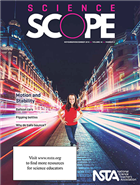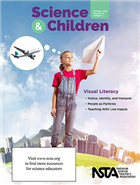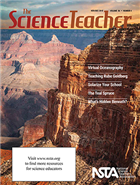Ideas and inspiration from NSTA’s November 2018 K-12 journals
By Mary Bigelow
Posted on 2018-11-12
Regardless of what grade level or subject you teach, check out all three K-12 journals. As you skim through titles and descriptions of the articles, you may find ideas for lessons that would be interesting for your students, the inspiration to adapt a lesson to your grade level or subject, or the challenge to create/share your own lessons and ideas.
NSTA members, as always, have access to the articles in all journals! Click on the links to read or add to your library.
 Science Scope – Motion and Stability
Science Scope – Motion and Stability
From the Editor’s Desk: Playing With Forces and Motion –”…because forces and motion are central to our lives, it is easy for students to harbor misconstructions as a result of observations made in daily life. Unfortunately, these misconstructions can lead to inaccurate conclusions that can be difficult to dispel…[students] need to confront their misconceptions through lab experiences that require them to observe, apply, and explain.”
- Articles in this issue that describe lessons (many of which use the 5E model) include a helpful sidebar documenting the big idea, essential pre-knowledge, time, safety issues, and cost. The lessons also include connections with the NGSS.D
- Enhance your cars-and-ramps investigation with learning stations and a culminating activity designed for Exploring Newton’s Laws of Motion With a Balloon Car
- The authors of Astronomy That Makes Sense note that “our attempts to make astronomy more understandable for visually impaired students also helped our middle school students better understand astronomy concepts.”
- The lesson in Demolishing Traditional Approaches to Science Instruction is an example of “Problem-Based Enhanced Language Learning” (PBELL) in which students work collaboratively on a problem. The authors also describe how to scaffold students’ science content and language.
- Systems and models are the focus of Teacher’s Toolkit: Using a Systems Thinking Approach to Figure Out Why a Ball Drops, Bounces, and Stops. The article includes a graphic listing practices of “systems thinkers.”
- Using simple materials, students explore how the force of friction affects the motion of objects with the activities in Disequilibrium: Newton’s Bottle
- Another investigation using simple materials is described in Bottle Flipping. The article includes examples of questions to investigate.
- Science for All: Using the Textbook Effectively to Encourage Student Growth describes strategies that support students to learn from science texts: think-alouds, guided notes, jigsaw discussions, text data sets, and a carousel activity.
- Citizen Science: Raspberry Shake describes a project in which students monitor the movement of the Earth in their geographic area and view real-time data from around the world.
- Change your word wall from a bulletin board to a student-led, interactive tool for learning. Interdisciplinary Ideas: Strengthening Your Word Wall shows you how, with examples of student input and design.
- Creating a graph is a first step in data analysis. But students may need help with what the graphs mean. Teacher to Teacher: Classroom Strategies for Analyzing and Interpreting Graph Data shows how students can be guided through an analysis. The photos of student work illustrate this.
- Deriving Ohm’s Law Using a Guided-Inquiry Investigation goes beyond students assembling a light bulb circuit to investigating the relationship between voltage and current through a resistor.
These monthly columns continue to provide background knowledge and classroom ideas:
- Scope on the Skies: Virtual Space Exploration
- Classic Lessons 2.0: Project- and problem-based learning and assessment (Newton’s Laws and roller coasters)
For more on the content that provides a context for projects and strategies described in this issue, see the SciLinks topics Cell Structure, Cells, Electric Circuits, Energy Transformations, Friction, Gravity, Law of Conservation of Energy, Metric System, Motion-Speed Relationship, Newton’s Laws of Motion, Newton’s First Law, Newton’s Second Law, Newton’s Third Law, Ohm’s Law, Pendulums, Plate Tectonics, Roller Coaster Physics,
Many authors share resources related to the lessons and strategies in their articles. These resources include rubrics, graphic organizers, handouts, diagrams, lists of resources, and complete lessons. You can access these through the Connections link for Science Scope.
Continue for Science & Children and The Science Teacher
 Science & Children – Visual Literacy
Science & Children – Visual Literacy
Editor’s Note: Learning Through Learning “It’s a visual world out there, so we must make the most of it to provide our students the opportunities to engage, explore, explain, elaborate, and evaluate their thinking and learning.”
The lessons described in the articles have a chart showing connections with the NGSS. Many are based on the 5E model and include classroom materials, illustrations of student work, and photographs of students engaged in the activities.
- Most children are fascinated by insects, and any negative attitudes are probably learned. Teaching With Live Insects summarizes a lesson that uses live “nonbiting, nonflying, and docile” insects (descriptions provided) as a basis for studying their structure, habitats, interactions, defenses, and life cycles.
- Offshore Oil Drilling exemplifies how to incorporate visual thinking strategies for students into learning about a current topic and communicating their learning.
- “We live in a world in which we are saturated with visual images and our students need to be able to critically analyze those images through visual literacy investigations, such as the diaper investigation” described Absorbing Visual Literacy. The lesson incorporates a study of absorbency, solutions, and polymers into an authentic experience in product testing.
- The lesson in Notice, Identify, and Interpret incorporates “heart circulation inquiry stations” and models. The article also has a table describing the types of visuals found in science texts and trade books and suggestions for helping students make sense of these visuals.
- People as Particles has ideas for guiding students through the modeling process (including visual modeling and physical movement as modeling). The article includes examples of student work describing the states of matter.
- The Early Years: Analyzing Media Representations of Animals includes a discussion and lesson designed to help young students learn the concepts of scale and proportion, especially with how unfamiliar animals are represented in visuals.
- In addition to recommending books on animal adaptations, Teaching Through Trade Books: From the Tip of a Beak to the End of a Tail has two lessons: What Does That Body Part Help Me Do? (K-2) and Beautiful Bird Beaks (3-5).
- Formative Assessment Probes: Magnets in Water includes a chart on integrating probes with Talk-Listen-Restate scaffolding as a more structured form of student sharing.
- The visual activity in Methods and Strategies: Draw a Scientist can uncover student misconceptions and stereotypes.
These monthly columns continue to provide background knowledge and classroom ideas:
- Science 101: Is It Really Caused by the Bernoulli Effect?
- Teaching Teachers: Learning Science and Literacy Together
- The Poetry of Science: Visual Poetry
- Engineering Encounters: Bears on a Boat Plus (ideas for English Language Learners)
For more on the content that provides a context for projects and strategies described in this issue, see the SciLinks topics Adaptations of Animals, Animals, Bernoulli’s Principle, Birds, Body Systems, Bugs, Circulatory System, Dissolve, Habitats, Heart, Insects, Life Cycles, Magnets, Mixtures, Ocean Drilling, Properties of Matter, Reading and Writing in Science, Senses, Solutions, States of Matter
Two articles from this month’s Science Scope also address visual literacy:
- Change your word wall from a bulletin board to a student-led, interactive tool for learning. Interdisciplinary Ideas: Strengthening Your Word Wall shows you how, with examples of student input and design.
- Creating a graph is a first step in data analysis. But students may need help with what the graphs mean. Teacher to Teacher: Classroom Strategies for Analyzing and Interpreting Graph Data shows how students can be guided through an analysis. The photos of student work illustrate this.
Many authors share resources related to the lessons and strategies in their articles. These resources include rubrics, graphic organizers, handouts, diagrams, lists of resources, and complete lessons. You can access these through the Connections link for Science & Children.
 The Science Teacher – Virtual Oceanography, Teaching Rube Goldberg, Solarize Your School
The Science Teacher – Virtual Oceanography, Teaching Rube Goldberg, Solarize Your School
Editor’s Corner: Fire and Rain ” The events of summer 2018 warn us that climate change is not a far-off event. [It] is real, it is caused mainly by human activity, and it is here now. Teachers must stand up for evidence-based climate science. We need to prepare students with the accurate knowledge that can prepare and inspire them to take action on a personal, community, and global level.” See the NSTA position statement on the Teaching of Climate Change.
The lessons described in the articles include a chart showing connections with the NGSS. The graphics are especially helpful in understanding the activities and in providing ideas for your own investigations.
- With the ideas in Virtual Oceanography, students plan a virtual scientific cruise, using satellite imagery and models. The lesson uses the Gulf of Mexico as a study site, but any body of water could be the focus.
- Approaches to Teaching Rube Goldberg has problem-solving ideas for incorporating the design, constructing, and testing of this type of apparatus in physics lessons on energy transfers, machines, and Newton’s Laws. The activities described use simple materials.
- Challenge students to study and design ways to Solarize Your School. The article includes a timeline to guide students with the problems and possible solutions.
- Although The Teal Spruce is not an actual species of conifer, the fictional species serves as a context for game-like model of why populations of living things live where they do and the effects of climate change on these populations.
- Many lessons focus on the Earth’s surface. What’s Hidden Beneath? takes on the question “What does the Earth’s subsurface look like?” with an emphasis on spatial skills, visualization, and 2D and 3D representations, using the Grand Canyon as an example.
- The authors of Idea Bank: Evolutionary Medicine in the Classroom suggest using the “interaction of evolution and human health as an organizing thread within biology, health, and physioanatomy” and provide resources for doing so.
- Focus on Physics: The Color Black discusses how the results of combining pigments and mixing lights are different.
These monthly columns continue to provide background knowledge and classroom ideas:
- Career of the Month: Mechanical Engineer
- Right to the Source: Using 5E to Explore an Epitome of the Universe
For more on the content that provides a context for projects and strategies described in this issue, see the SciLinks topics Climate Change, Collisions, Color, Estuaries, Evolutionary Biology, Glaciers, Grand Canyon, Newton’s Laws of Motion, Plankton, Simple Machines, Solar Energy, Solar Heated Homes, Salinity, Stratigraphy, Transfer of Energy, Visible Light, Vision,
Many authors share resources related to the lessons and strategies in their articles. These resources include rubrics, graphic organizers, handouts, diagrams, lists of resources, and complete lessons. You can access these through the Connections link for The Science Teacher.
Disclaimer: The views expressed in this blog post are those of the author(s) and do not necessarily reflect the official position of the National Science Teaching Association (NSTA).


